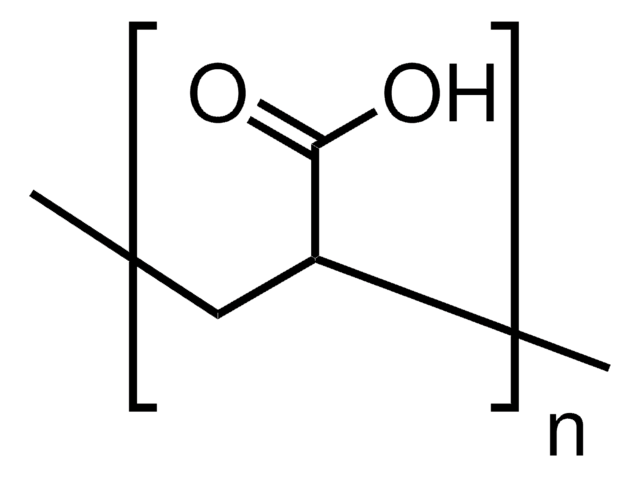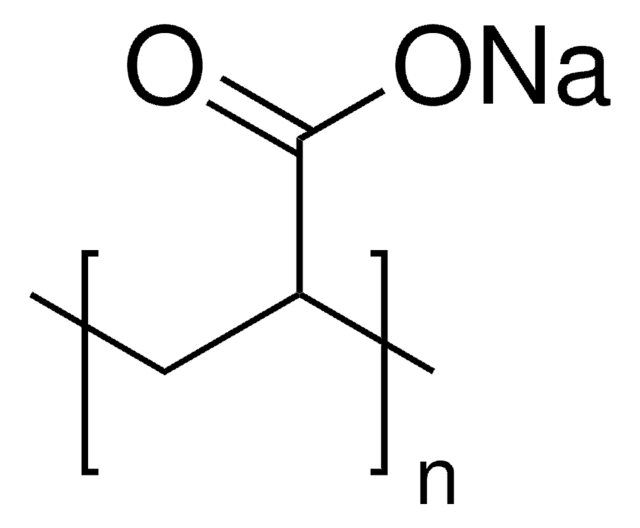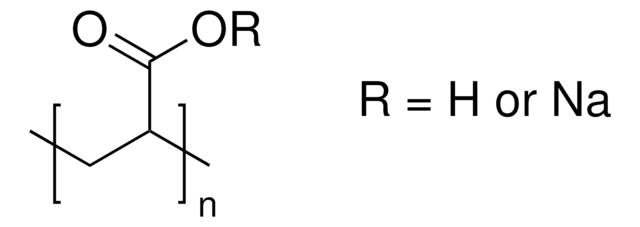416010
Poly(acrylic acid, sodium salt) solution
average Mw ~1,200, 45 wt. % in H2O
Synonyme(s) :
PAA, Sodium polyacrylate
About This Item
Produits recommandés
Forme
viscous liquid
Niveau de qualité
Poids mol.
average Mw ~1,200
Concentration
45 wt. % in H2O
Indice de réfraction
n20/D 1.43
Densité
1.32 g/mL at 25 °C
Chaîne SMILES
[Na]OC(=O)C=C
InChI
1S/C3H4O2.Na/c1-2-3(4)5;/h2H,1H2,(H,4,5);/q;+1/p-1
Clé InChI
NNMHYFLPFNGQFZ-UHFFFAOYSA-M
Vous recherchez des produits similaires ? Visite Guide de comparaison des produits
Catégories apparentées
Application
Itcan be used as a draw solute in forward osmosis process due to its flexibilityin structural configuration and high solubility in water. They can be preferredover conventional ionic salts as they can produce comparable water flux andmuch lower reverse leakages.
It can also be used to study the effect of the molecular weight of PAAon crystal nucleation and the growth of CaCO3 during thecrystallization process.
Code de la classe de stockage
10 - Combustible liquids
Classe de danger pour l'eau (WGK)
WGK 1
Point d'éclair (°F)
Not applicable
Point d'éclair (°C)
Not applicable
Équipement de protection individuelle
Eyeshields, Gloves, type ABEK (EN14387) respirator filter
Faites votre choix parmi les versions les plus récentes :
Déjà en possession de ce produit ?
Retrouvez la documentation relative aux produits que vous avez récemment achetés dans la Bibliothèque de documents.
Les clients ont également consulté
Articles
Magnetic-plasmonic nanoparticles offer the combined benefits of both a magnetic probe as well as additional imaging modes usually associated with noble metal nanoparticles. Professor Shinya Maenosono (Japan Advanced Institute of Science and Technology) explores the synthesis, characterization, and proof-of-concept application of Ag/FeCo/Ag core/shell/shell magnetic-plasmonic nanobeads for imaging and isolation of cellular organelles (autophagosomes of COS-1 cells).
Recently, layer-by-layer (LbL) assembly has emerged as a versatile, gentle and, simple method for immobilization of functional molecules in an easily controllable thin film morphology.1,2 In this short review, we introduce recent advances in functional systems fabricated by using the mild, yet adaptable LbL technique.
We present an article that discusses two applications in particular; first, using these layers as polyelectrolyte membranes to control permeability.
Notre équipe de scientifiques dispose d'une expérience dans tous les secteurs de la recherche, notamment en sciences de la vie, science des matériaux, synthèse chimique, chromatographie, analyse et dans de nombreux autres domaines..
Contacter notre Service technique


